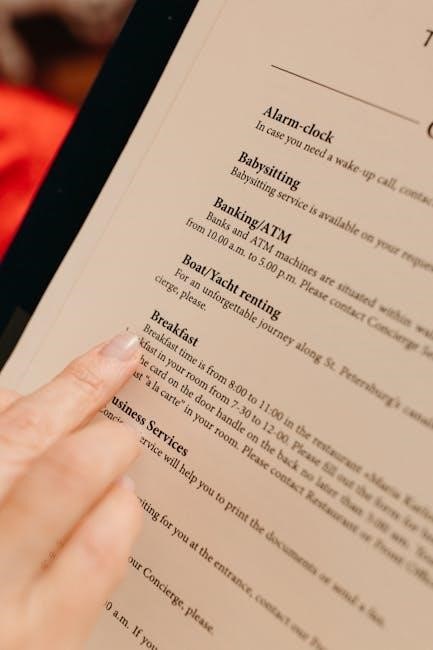
Boat guides for trailers simplify the process of aligning and securing your watercraft. They ensure proper centering, reduce frustration during loading, and enhance safety while towing. Easy to install, they improve efficiency and peace of mind for boat owners.
What Are Boat Guides and Their Purpose
Boat guides are essential accessories designed to assist in aligning and centering your boat during loading and unloading on a trailer. They are typically attached to the trailer and serve as visual or physical aids to help guide the boat into the correct position. These guides can be fixed or adjustable, depending on the type, and are often used in conjunction with bunk boards or rollers. Their primary purpose is to simplify the process of securing the boat onto the trailer, reducing the risk of misalignment and potential damage. By providing a clear path for the boat to follow, guides enhance safety, efficiency, and ease of use for boat owners. They are particularly useful for novice boaters or those who frequently load and unload their watercraft; Overall, boat guides are a practical solution for ensuring a secure and stress-free towing experience.
Importance of Boat Guides for Safe Towing and Loading
Boat guides play a crucial role in ensuring safe and efficient towing and loading processes. By providing clear alignment assistance, they help prevent damage to both the boat and trailer, reducing the risk of costly repairs. Proper alignment also minimizes the chance of accidents during loading or unloading, ensuring a secure fit on the trailer. This added stability is particularly important for novice boaters or those towing in challenging conditions. Guides also enhance safety on the road by keeping the boat properly centered, which improves towing stability and reduces the risk of swaying or shifting. Overall, boat guides are an essential component for maintaining safety, preventing potential hazards, and making the towing experience more manageable and stress-free for boat owners.

Types of Boat Guides
Boat guides come in types such as bunk and roller guides, designed to align and secure your boat on the trailer for safe towing and easy loading, enhancing stability.
Bunk Guides vs. Roller Guides: Which Is Better for Your Trailer
Bunk guides and roller guides are two popular options for aligning and securing boats on trailers. Bunk guides are ideal for trailers with bunk boards, providing stability and support during towing. They are especially suitable for boats that spend extended periods on the trailer, as they cradle the hull and protect it from damage. Roller guides, on the other hand, are designed for smoother loading and unloading, reducing friction as the boat moves onto the trailer. They are often preferred for frequent launching and retrieval. Choosing between the two depends on your specific needs, trailer type, and how often you plan to load and unload your boat. Both options enhance safety and convenience, ensuring your boat is properly aligned and secured for optimal performance.
Adjustable vs. Fixed Boat Guides: Pros and Cons
Adjustable boat guides offer versatility, allowing customization to fit various boat sizes and trailer setups. They are ideal for owners who use multiple boats or need precise alignment. However, they may require more maintenance to ensure stability. Fixed guides provide durability and simplicity, with no moving parts to adjust or wear out. They are perfect for trailers with consistent boat sizes, offering reliable performance. Adjustable guides suit those needing flexibility, while fixed guides are better for simplicity and long-term reliability. Consider your specific needs, such as frequency of use and boat variety, when choosing between the two. Both options enhance safety and ease of use, ensuring your boat is securely aligned and protected during towing and storage.

Choosing the Right Boat Guides for Your Trailer
Selecting the right boat guides involves assessing your trailer type, boat size, and personal preference to ensure a proper fit and ease of use.
How to Measure Your Boat and Trailer for Proper Fit
To ensure a proper fit, start by measuring the width of your boat at its widest point and compare it to the trailer’s bunk length. This ensures the boat will sit securely. Next, measure the distance between the trailer’s bunk brackets to determine where the guides should be mounted. Proper alignment is crucial to prevent damage and ensure safe towing. Use a tape measure to record these dimensions accurately. Additionally, consider the height of the boat when it’s on the trailer to ensure the guides are positioned correctly. If your boat has specific features, such as a wider transom or a unique hull shape, these should also be taken into account. Accurate measurements will help you choose the right size and type of guides, ensuring a snug and secure fit. Always double-check your measurements to avoid errors during installation.
Materials and Durability: What to Look for in Boat Guides
When selecting boat guides, prioritize materials that offer durability and resistance to marine environments; Polyurethane and aluminum are popular choices due to their strength and corrosion resistance. Stainless steel components are also ideal for withstanding saltwater and harsh weather conditions. Look for guides with reinforced brackets and secure fastening systems to ensure stability. Durability is key, as boat guides are exposed to water, sunlight, and heavy use. High-quality materials will extend the lifespan of your guides and maintain their effectiveness. Additionally, consider guides with UV-resistant coatings to prevent fading and cracking from prolonged sun exposure. Durable boat guides not only enhance safety but also reduce the need for frequent replacements, making them a worthwhile investment for boat owners. Always inspect the construction and material quality before making a purchase to ensure long-term performance.

Installation of Boat Guides
Installing boat guides is straightforward, often requiring basic tools. Secure the guides to the trailer using U-bolts, ensuring proper alignment for safe and efficient boat loading. Follow manufacturer instructions carefully.

Step-by-Step Guide to Installing Bunk Guides
Installing bunk guides begins with measuring your trailer to ensure proper fit. Attach the guides to the trailer frame using U-bolts, tightening them securely. Align the guides with your boat’s hull, ensuring they are evenly spaced and centered. Adjust the guides to match the boat’s contour for optimal support. Finally, test the setup by gently loading the boat onto the trailer to ensure smooth alignment and stability. Regularly inspect and tighten the U-bolts to maintain a secure fit. Proper installation ensures safe towing and protects both the boat and trailer from damage.
DIY Tips for Modifying Trailer Brackets for Better Alignment
Modifying trailer brackets for better alignment involves designing a custom extension to enhance guide placement. Start by measuring your trailer and boat to determine the optimal position for the guides. Cut and drill metal brackets to fit your needs, ensuring they align with the boat’s hull. Attach the extension to the original bracket using bolts, and consider adding spacers for extra stability. Weld the assembly for durability and sand rough edges to prevent damage to the boat. For a precise fit, test the alignment by loading the boat onto the trailer. This DIY approach ensures a secure and centered position, making launching and loading easier while protecting your boat from hull damage during transport. Regular inspections and adjustments will maintain optimal alignment over time.

Maintenance and Care
Regularly inspect boat guides and bunk boards for wear or damage. Clean guides to ensure smooth operation and replace any worn-out components promptly to maintain optimal performance and safety.
Inspecting and Cleaning Boat Guides for Optimal Performance
Regular inspection of boat guides is crucial for ensuring safe and efficient trailer operation. Look for signs of wear, such as frayed carpeting, bent metal, or damaged rollers. Clean the guides thoroughly with mild soap and water to remove dirt, grease, or debris that may hinder smooth operation. Inspect the pivot points and hinges for proper lubrication, applying marine-grade grease if necessary. Check the alignment of the guides to ensure they are straight and evenly spaced. Cleaning and inspection should be done after each use and before long trips. Neglecting maintenance can lead to misalignment, damage to the boat hull, or difficulty during loading and unloading. Keep replacement parts on hand for worn components to maintain optimal performance and safety.

When to Replace Worn-Out or Damaged Guides
Knowing when to replace worn-out or damaged boat guides is essential for maintaining safe and efficient trailer performance. If the guides show significant wear, such as frayed carpeting, bent metal frames, or broken rollers, it’s time to replace them. Look for signs of rust or corrosion, as these can weaken the structure and lead to failure. Additionally, if the guides are no longer aligning the boat properly or causing scratches or damage to the hull, replacement is necessary. Consider upgrading to high-quality, durable materials like stainless steel or heavy-duty plastic for longevity. Replace the guides immediately if they become loose or detached, as this can compromise safety during towing. Regular replacements ensure optimal performance and protect both the boat and trailer from further damage.

Safety Tips for Using Boat Guides
- Always ensure proper and safe boat alignment on the trailer to prevent shifting during towing.
- Use tie-down straps to secure the boat tightly.
- Keep guides fastened to avoid movement.
- Regularly inspect guides for wear and tear to maintain safety.
Best Practices for Loading and Unloading Your Boat
When loading or unloading your boat, ensure the trailer is properly aligned with the boat’s centerline to maintain balance. Always use the boat guides to help center the vessel on the trailer. Move the boat slowly and straight to avoid misalignment. Secure the boat to the trailer using tie-down straps and ensure all safety chains are properly attached. Never load or unload in shallow water, as this can damage the guides or the boat. Always inspect the ramp area for obstacles and ensure the surface is level. Use a spotter if possible to guide you during the process. After loading, double-check that the boat is securely fastened to prevent shifting during transport. Regular practice will improve your technique and reduce the risk of accidents. Proper loading and unloading are critical for safe towing and protecting your equipment.
How to Secure Your Boat Properly During Towing
Securing your boat properly during towing is essential for safety and preventing damage. Start by ensuring the boat is centered on the trailer and aligned with the hitch. Use high-quality tie-down straps to secure the boat to the trailer, focusing on the bow and stern. Attach the straps to the trailer’s frame, not the axles, to distribute the load evenly. Tighten the straps firmly but avoid over-tightening, which could damage the boat’s hull. Install safety chains on the trailer to act as a backup in case the hitch fails. Ensure the trailer’s coupler is securely locked to the towing vehicle. Periodically check the straps and chains during long trips to ensure they remain tight. Proper securing prevents shifting, reduces wear on the boat guides, and ensures a smooth towing experience. Always follow the manufacturer’s guidelines for securing your specific boat and trailer combination.

Troubleshooting Common Issues
Identify issues like misalignment or wear by inspecting boat guides regularly. Address problems promptly to ensure safe towing and prevent further damage to your boat or trailer system.
Why Your Boat Might Not Align Properly on the Trailer

Misalignment of your boat on the trailer can stem from several factors. Incorrectly set trailer bunks or guides, worn-out rollers, or damaged brackets often disrupt proper alignment. Additionally, improper loading techniques, such as not centering the boat or failing to secure it evenly, can lead to misalignment. Weather conditions like strong winds or uneven ramps may also make alignment challenging. Furthermore, if the trailer’s axle or suspension is unevenly loaded, it can cause the boat to sit crookedly. Regular inspections and adjustments of the trailer setup and guides are essential to prevent these issues. Ensuring the boat is loaded and secured correctly, along with maintaining the trailer’s structural integrity, will help achieve proper alignment for safe towing and storage.
Fixing Misaligned or Loose Boat Guides
If your boat guides are misaligned or loose, addressing the issue promptly is crucial for safe towing; Start by tightening all mounting hardware and ensuring the guides are securely fastened to the trailer frame. If the guides are adjustable, realign them to match the boat’s hull shape and position. For misaligned guides, check the trailer’s bunk system and adjust the rollers or bunks to center the boat properly. Lubricating moving parts can also improve alignment and reduce friction. Regularly inspect the guides for wear or damage and replace any faulty components. Tightening loose brackets or repositioning the guides may require tools like wrenches or sockets. Ensuring proper alignment not only prevents damage during towing but also makes loading and unloading easier. Always refer to your trailer’s manual for specific adjustment instructions.